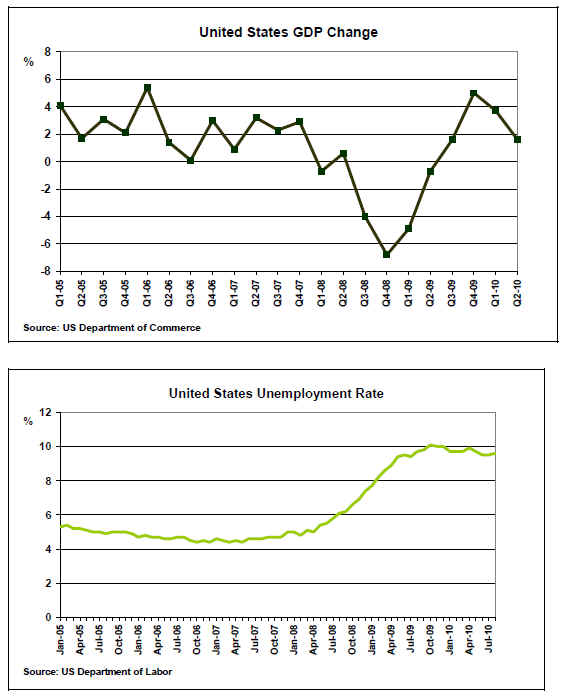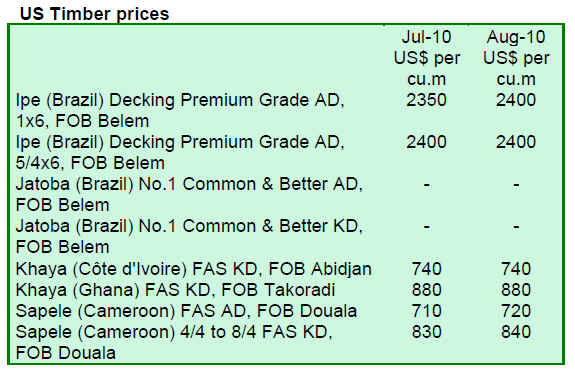|
Report
from
North America
US economic update
The US economy grew at a much slower pace than the government previously expected. In the second quarter of 2010 the GDP grew at an annual rate of 1.6%, down from 3.7% in the first quarter, according to the US Department of Commerce. Especially small and medium-sized companies suffer from slow domestic demand and the continually poor housing market. While the economy remains weak, the data does not indicate another recession. The Conference Board forecasts the US economy to grow by 2.7% in 2010 and 1.8% in 2011.
Unemployment
In August, the national unemployment rate was 9.6%, up from 9.5% in June and July according to the US Department of Labor. While the number of new jobs created by employers increased in August, the US labour force also grew, thereby pushing up the unemployment rate. The number of jobs advertised rose by over 6% in July after two months of decline. Job openings remain far below pre-recession levels.

Consumer spending
High debt levels and a lack of confidence in the economy are also holding back the economic recovery. Consumer spending accounts for approximately 70% of the US economy. While the consumer confidence index by the Conference Board improved in August, at 53.5 it remains far below 90, the level that indicates a healthy economy.
Consumer spending rose by 0.4% in July after little change in the previous three months, according to the US Department of Commerce. The increase in spending was the highest since March, but economists worry that consumer spending will stall if unemployment remains high. Personal incomes increased by 0.2% in July. Despite this recent increase in spending, the household savings rate is three times higher than before the recession started. Consumers remain cautious, especially when it comes to buying on credit.
Manufacturing
According to the Institute for Supply Managementí»s manufacturing index, US manufacturing companies are leading the economic recovery. Manufacturing has expanded for over a year according to the index. Continuing strong growth in China and other developing economies has provided a market for US manufacturers, offsetting slow domestic demand. In July, US industrial production rose by 1% after a 0.1% decline in June.
Foreign trade
The US trade deficit with the world plummeted by 14% in July according to the US Department of Commerce. The value of US exports grew by 1.8% while imports fell by 2.1%. This is a significant change from the second quarter when the trade deficit widened and GDP growth slowed. However, the drop in imports reflects lower domestic demand from businesses and consumers. The largest trade deficit remains with China, and the US Congress is being lobbied for trade sanctions against China unless the Yuan is allowed to rise in value against the US dollar.
President Obama proposes new policies to stimulate economy
With unemployment remaining relatively high and mid-term elections looming in November, President Obama proposes three measures to support the US economy:
• US$50 billion in long-term spending for roads, railways, high speed rail projects and airport runways;
• Permanent extension of research and development tax credits for businesses; and
• Tax breaks to allow businesses write off 100% of their spending on new plants and equipment through
2011.
While infrastructure improvements were part of the 2009 US$814 billion stimulus that is nearing its end, the new proposal aims at long-term improvements in the USí»s transportation infrastructure, some of which is forty or more years old.
The president also proposes not to extend the tax breaks that the Bush administration introduced. The tax breaks are due to expire in January 2011, and Obama wants to retain them only for low- and middle-income families.
It is unclear whether the proposed changes will be approved by Congress given the timing before the mid-term elections, but several of the policies had previously been proposed by the Republicans who will be challenging the Democratsí» majority in both houses (Congress and House of Representative) at the November elections.
Canada economic update
Canadaí»s economic recovery has slowed given the weaker outlook for the global economy and the US, Canadaí»s largest export market. Nevertheless, the economy is producing almost as much as it did before the recession and employment is also close to pre-recession levels. Unemployment stood at 8% in July. Canadaí»s central bank projects the economy to grow by 3.5% in 2010, 2.9% in 2011 and 2.2% in 2012.
Canadaí»s central bank raised its benchmark interest rate by a quarter point to 1% on September 8. This is the third consecutive raise since Canada was the first of the G7 countries to raise its interest rate in June. While the economic outlook for Canada is less positive now because of the weak performance of the US economy, the central bank governor said there is no longer a need for very low emergency interest rates. In April 2009, the rate had been set at 0.25%, a historic low.
Investment in residential construction and renovation has slowed significantly because of a combination of factors:
• Expiry of the home renovation tax credit in February 2010;
• Tightening of mortgage criteria;
• Increase in mortgage rates; and
• High house prices.
Manufacturing sales increased slightly in June according to the most recent data from Statistics Canada. The highest increases were posted by the furniture industry (+6.4%) and the paper industry (+4.8%).
Canadaí»s trade surplus with the US narrowed. Since December 2009, exports to the US have fallen by 2.2% while imports have increased by 14.1% according to Statistics Canada. Exports to the rest of the world, especially to the EU, grew by 3.7%. Exports of forest products fell by 1.5% to C$1.8 billion after ten consecutive months of growth.
American hardwood promotion in the United Arab Emirates
The American Hardwood Export Council (AHEC) will conduct a free workshop for architects and interior designers in Dubai at the end of September. The seminar will include an introduction to the NHLA grading rules, wood species and the environmental credentials of American hardwoods. AHEC is seeking to increase hardwood exports to the Middle East for use in interior furnishings, flooring and doors. Saudi Arabia and the UAE are the largest markets for US hardwoods in the region and have shown strong growth in recent years. According to AHEC, red oak is the most sought-after species.

Related News:
|